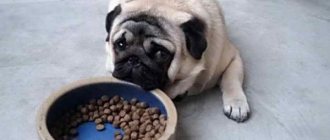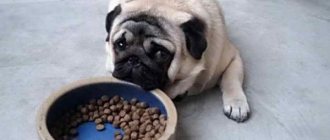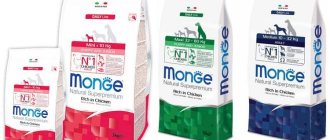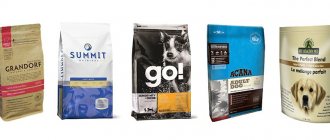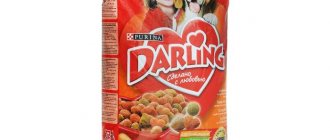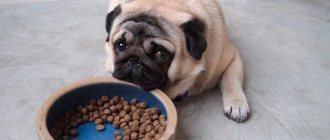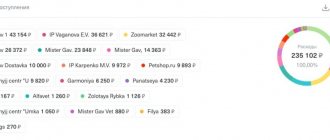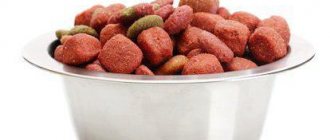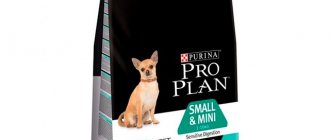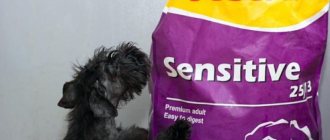Probably every pet owner has tasted dry food out of curiosity. But how it is prepared and what it actually consists of, we can only guess, because there are a huge number of rumors surrounding the preparation of dry food. The Royal Canin company offered to find out how the process of making dry food for dogs and cats actually happens, opening the doors to its production.
The Royal Canin plant is located in the Dmitrovsky district of the Moscow region on 14.8 hectares. The factory was built using vertical technology (maximum height 33 meters) and takes up very little space in comparison with both competitors and cheap feed analogues. The plant was opened in 2004, and in 2015 a second production line was launched, which doubled the plant’s capacity.
How to choose the right lump for your dog
Inexperienced owners often do not know how to choose the right dog for their dog. Relying on intuition, the owner falls for the marketer’s “hook” and begins to feed the dog the most popular, but low-quality food.
The quality of the feed should always be at the forefront. Remember that it is better to feed your dog natural food than cheap food of questionable quality.
Moreover, a natural diet is cheaper in terms of feed. However, ready-made food has an undeniable advantage - it does not need to be prepared, and this saves a lot of time.
The origin of modern dogs and the characteristics of their body
Scientific research has proven that the DNA of modern dogs is more than 99% similar to the genetic structure of wolves (Canis lupus). Like their wild ancestors, dogs have features of physiology and digestion characteristic of predators:
- sharp teeth and strong jaws designed for gnawing and grinding food;
- a short gastrointestinal tract with high acidity of gastric juice, which allows you to quickly digest meat foods, easily break down animal protein and destroy pathogenic bacteria;
- Dog saliva lacks amylase, an enzyme necessary for digesting carbohydrates. The pancreas takes on the role of producing it. Therefore, the amount of carbohydrates in the animal’s diet should be limited.
That is why it is very important to take into account the nature of the dog’s origin and respect the needs of its body when choosing a diet.
Types of industrial feeds
Types of industrial feed are usually divided according to quality and “aggregate” state. Both indicators are extremely important at the stage of choosing a new food for your pet, especially if you are switching it from natural food.
Dry food
Dry food is the granules familiar to everyone. Dogs will happily eat dry food if it is of high quality or contains flavor enhancers. Remember that the pet's reaction is not an indicator of quality, since the dog can be deceived by its own feelings.
Note! Dry food includes treats - crackers, coquettes, etc. These are different subspecies, but one “line” of food.
Dry food is convenient to store and dose – these are undoubted advantages. In addition, the dry food is of high quality and truly balanced. The only caveat is dental health. If a dog eats only dry food, its tooth enamel quickly deteriorates. To prevent dental problems, an adult dog's diet should consist of 70–75% dry food and 25–30% wet food.
Wet (canned) food
Wet (canned) food is a favorite treat for most dogs. The pet looks forward to such treats and “recognizes” the treat by the rustling of the bag or the sound of the jar opening.
Note! Wet foods include kibbles with gravy, pates and pastes. The amount of water in products varies.
In terms of quality, wet food is almost always similar to dry food of the same line and series. The only difference is the water content, which can vary from 40 to 60%. Taking into account the fact that canned food is more expensive than dry food and they contain water, which you also pay for, the final cost of food turns out to be quite high.
Price and where to buy
Food of this brand can be purchased in online pet stores:
- “Old Farm” (reference): Best Choice dry food 4 kg - from 1,499 rubles;
- Dry food Best Choice 20 kg - from 4206 rub.
- Best Choice packaging 4 kg - from 917 rubles;
Prices shown are current as of mid-December 2022 and may change over time. For the exact cost, see the pet store websites using the information above.
Feed classes
Feed classes are a direct indicator of quality. There are four classes in total, so even an inexperienced owner has clear “guidelines”. However, it is important to remember that assigning a class to a particular food is not regulated by law. In some countries, manufacturers have to confirm the quality of raw materials. Many eminent people themselves turn to “human” laboratories to confirm the quality of the products from which the raw materials are made.
Why is the food class “dust in the eyes” and you always need to read the composition? If the manufacturer writes premium on the pack, but the food is in fact economy, no one will punish him. Yes, the reputation of the trade poppy among those in the know will deteriorate, but the manufacturer will still pinch off a piece of its market.
It is by this logic that economy feeds are the most popular. Owners are not convinced by veterinarians, the experience of “colleagues,” or the dog’s poor health. They are under the pressure of marketing and advertising slogans, and they understand the truth too late.
Economy class
Economy class food is characterized by a relatively low price and alarmingly low quality. Products rarely contain meat, at best - by-products. Typically, the composition is dominated by low-grade cereals - wheat, barley, corn. However, you shouldn’t get your hopes up here either; the food does not contain grains, but their waste.
Guaranteed performance expected from economy class:
- Proteins – from 20%.
- Fats – from 11%.
- Fiber (fiber) – from 2%.
- Moisture up to 15%.
- Calorie content up to 300 kcal per 100 g.
Despite its widespread popularity, recognition and aggressive marketing, economy feed is not recommended by veterinarians. Almost all products in this class are hazardous to health if consumed for a long time.
Premium class
Premium class is the next “step” and the widest segment of ready-made feed. Premium food can be recognized by its rich assortment, composition, which includes a modest amount of meat and basic vitamin supplements.
Guaranteed performance expected from premium class:
- Proteins – from 25%.
- Fats – from 12%.
- Fiber (fiber) – from 3%.
- Moisture up to 12%.
- Calorie content 300–350 kcal per 100 g.
Premium food is distinguished by its high content of plant proteins and carbohydrate content. It is on premium food that healthy dogs, to the surprise of their owners, gain excess weight very quickly. Premium food is suitable for everyday feeding of young, healthy dogs.
Super premium class
Super premium class is a wide segment of finished products that is optimal for everyday feeding. Super premium feed usually includes meat, offal, cartilage and meat and bone meal.
Guaranteed performance expected from super premium class:
- Proteins – from 28%.
- Fats – from 13%.
- Fiber (fiber) – from 3.5%.
- Moisture up to 10%.
- Calorie content 350-400 kcal per 100 g.
It is important to remember that it is in the super premium segment that there is the most serious “gap” in quality and prices. Read the ingredients carefully; if something seems unclear or suspicious to you, it is better to choose another food. In fairness, it should be noted that in the super premium segment there are very worthy foods.
Holistic
Holistic is a class of food that is almost the same in quality as super premium food, but is made from human grade products (products that are suitable for human consumption). The production of holistic feeds “began” with the idea of adequate “recycling” of products that had already been produced, but turned out to be unnecessary. supply found demand, so a new class appeared - holistic.
Guaranteed indicators that are expected from the holistic class:
- Proteins – from 32%.
- Fats – from 15%.
- Fiber (fiber) – from 4%.
- Moisture up to 8%.
- Calorie content 400-450 kcal per 100 g.
It should be noted that the holistic class is the most expensive food. Upon careful study of the composition, it often turns out that the holistic product has a cheaper and higher quality competitor, super premium class. There is only one conclusion: always read the composition and reviews of the food before switching your pet to it.
Hydrolyzed animal proteins
Not everyone has been scared yet?
Then let's look at another ingredient in premium cat food. Do you already understand what lies behind the streamlined formulations?
Animal protein hydrolyzate is a liquid or powder with the taste and smell of animal products. In order to obtain it, animal waste is treated with special enzymes. As a result, proteins are broken down into peptides and free amino acids. Then they are evaporated under vacuum at low temperature - this way the solution becomes more concentrated or turns into powder. ⠀ The nutritional value of this ingredient, according to the checkpoint service, is 1 point out of 10. Why is it used? The fact is that any hydrolyzed animal protein is a powerful natural flavoring agent that makes the taste of industrial feed more attractive. Typically, hydrolyzate is added to feed in small quantities for precisely this purpose. But sometimes it is used as a complete nutritional ingredient and source of animal protein in animal and fish feeds - in this case, the hydrolyzate is listed among the first five ingredients. ⠀ It is believed that animal protein hydrolyzate is well absorbed, but it is chemically processed, and it is unknown what raw materials it was obtained from. We remind you that natural meat components (with an indication of their origin) are much healthier for healthy animals. The chain of pet stores Lapa & Co has a large selection of just such food. our experts and choose the one that best suits your pet ❤️
Differences in food based on dog size
The main differences in food based on the size of the dog are the ratio of ingredients and their calorie content. Dogs of different sizes have different energy needs.
This is interesting! Contrary to logic, small dogs, in relation to their weight, need more food.
Small breeds
Small breeds are susceptible to hypothermia and overheating. During the cold season, the dog is often in the lower, coldest layers of air. Even in the warmer months, small dogs often shiver from the cold. For this reason, your pet needs to be fed and dressed very wisely in cold weather. The diet should be high in calories, but light.
In hot weather, while walking, the dog is exposed to the heat that comes from the ground and asphalt. At the same time, the pet practically does not get exposed to drafts. To make it easier for your dog to endure the heat, you need to constantly monitor its weight.
Medium breeds
The key difference between medium-sized dog breeds is their activity. The more active a dog is, the higher its energy needs. However, high activity is a good reason to feed your dog “cereal” food. Nutritious, balanced food, consisting of meat, vegetables, fruits. For additional sources of carbohydrates, if needed, consider legumes (processed) or sweet potatoes.
Large breeds
Large breeds are considered the most problematic, since it is difficult to raise a puppy, it is difficult to feed an adult dog, and it is difficult to support an elderly one. Love large dogs are ready for difficulties, but do not always take them with the proper degree of seriousness.
Food for large breed puppies should contain plenty of meat, amino acids and minerals. Only with this composition will the skeleton “have time” to form under the muscle mass. For adult dogs of large breeds, the balance of carbohydrates and proteins is extremely important, since the pet must eat well, but not gain weight. In old age, a large dog needs to be switched to a special food that takes into account the universal tendency to heart problems and diseases of the musculoskeletal system.
Reviews from leading veterinarians
Nikolay S.
“For the premium class, Winner’s products are good. Natural meat is present in sufficient quantities. Some components are controversial (corn, salt), but in general there is nothing critical in the diet."
Galina A.
“Meat is an essential component in the diet for dogs and cats. I’m glad that Wiener’s dry food contains it in sufficient quantity. The food can be called complete, because vitamins and proteins are also okay.”
Differences in feed composition
Differences in feed composition may affect all ingredients. Naturally, quality directly depends on key differences. You won't find the following in good food:
- Artificial preservatives, flavors (except broth), flavor enhancers.
- Soleil.
- Corn and wheat.
- Vegetable waste (pulp).
- Incomprehensible, double and ambiguous formulations.
Note! Ingredients are always listed in descending order.
Grain
Cereal contains cereals in the form of grains. Rice is considered an acceptable option. Of course, it would be better if there was buckwheat in the feed, but such products are produced in single versions and are practically not imported.
Note! Economy and premium grain feeds usually contain wheat and corn. In super premium food you can find processed wheat, rice, barley, and millet.
Grain-free
Grain-free food does not contain grains, but may contain legumes and lentils. Legumes lend themselves to specific processing, since in their natural form they are practically not digestible. Cereals (fillers) in food are replaced by meat, vegetables and fruits, which has a positive effect on the dog’s health.
Many people believe that grain-free foods are purely holistic and very expensive. In fact, such food is available in super-premium lines at more affordable prices.
Hypoallergenic
Hypoallergenic food is intended for dogs that have a negative reaction to food. Allergies can result in skin irritation and other symptoms. Rice is used as a grain in hypoallergenic food, but it is better to give preference to a grain-free diet.
Preservatives (E-shki), beef and chicken can act as allergens in food. The diet for an allergic dog needs to be selected individually, preferably together with a veterinarian.
For spayed and neutered dogs
Food for spayed and neutered dogs should not contain salts or products that can affect the acidity of urine. The main threat of improper feeding after castration is rapidly developing urolithiasis. The second threat is obesity, so the dog’s diet should be balanced and walks should be intense.
Note! Food for spayed and neutered dogs should be low in calories.
Medicinal (veterinary) food for dogs with health problems
Medicinal (veterinary) food for dogs with health problems is a specific product that has indications and contraindications. Remember that medicinal foods affect metabolism and the functioning of body systems. Medicinal food is prescribed by a veterinarian, in combination with therapy, and usually temporarily. A lifelong diet can only be used for severe, chronic diseases.
Important! You cannot feed your pet medicated food for prevention!
Winner's analogs
The following Russian-made feeds are available in the premium price segment:
- Royal Canin;
- Imperial-AS;
- Bisco.
Of the domestic premium feeds, Winner is the best in composition.
Foreign brands:
- Hills;
- Brit Premium;
- Advance.
Many of the above foods do not even contain dried meat. Or it is far from being in 1st place. For example, in Advance food the percentage of meat to other ingredients is no higher than 20%, while Winner ranges from 26 to 35%. This gives TM Winner an advantage, because here real meat is the first ingredient. Among other things, in the same Advance the composition is “finished” by wheat, while in the food from Miratorg there is only rice and corn.
